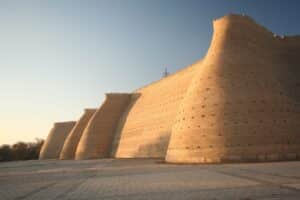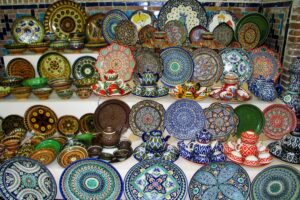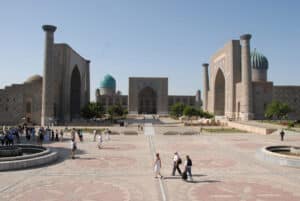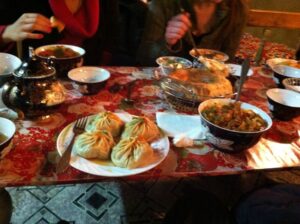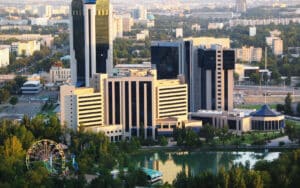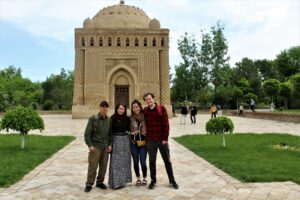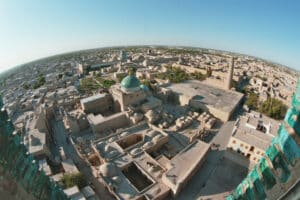Uzbekistan is a country that holds a very special place in my heart. I grew up in Uzbekistan but left due to political issues in 2006, so returning to Uzbekistan was like coming home. It was wonderful to be able to cross the border without a visa – since the death of former president Karimov, the Uzbek government has been making big changes to promote tourism, including unilaterally declaring liberalizations in visa policy. UK citizens (that’s me!) can now enter Uzbekistan for 30 days visa-free. Americans can enter for five days if they enter and leave the country via Uzbek Airlines and otherwise qualify for simple e-visas that are good for 30 days.
The following resource combines short histories of four of Uzbekistan’s major cities, written by SRAS Assistant Director Josh Wilson, with my experience traveling to three of those great and ancient Uzbek cities as part of SRAS’ Central Asian Studies program.
Bukhara
A Brief History of Bukhara
Bukhara is estimated to be about 2300 years old. It was conquered by Alexander the Great and was also once ruled by the Kushan Empire. However, when the Samanids later came into power, they created a large feudal state, with Bukhara as its capital. It was part of what came to be called the Golden Road, the meeting point of the northern and southern branches of the Great Silk Road, and hence a great center for commerce, religion, and culture.
In Sanskrit, Bukhara means “Monastery,” and was revered the Medieval Muslim East as a stronghold of the faith. In the 10th century, Bukhara became a scientific and cultural center, home to famous poets like Rudaki and Dakiki, and Avicenna, the great scientist and physician.
By the mid 19th century, Russia and Britain were both trying to gain control of Central Asia: Russia from the north and Britain from India in the south. Isolated since the time of the Silk Routes, Central Asia had not seen Western visitors for hundreds of years. Although Russia gained control of much of the region by 1868, Bukhara managed to keep its Emir as the master of the city. Inside the high walls, a strong anti-westerner sentiment was always present, fanned by the Emir himself. In 1918 the Russian revolution spread to Uzbekistan, but Bukhara never really fell into the fold until the city was almost destroyed and thousands of people were massacred by the Red Army on September 6, 1920.
Although Soviet rule lasted until 1991, the city never lost its Eastern culture and atmosphere, or its independent spirit. With more than 140 architectural monuments dating back to the Middle Ages, Bukhara is today a “museum town” with lots of history to see.
- Bukhara’s ancient mud-brick fortress.
- The edge of a marketplace in Bukhara,
- Delights to be found in the market.
Visiting Bukhara Today
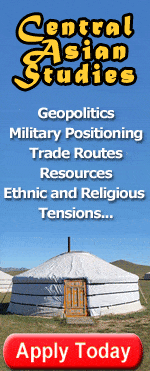
I was relieved that he waited, as it took 50 minutes to get through! Interestingly, I didn’t actually need to wait in lines as I was the only tourist so they bumped me to the front of all the queues. The reason it took so long was because the border was so wide and required two bus rides to get across.
Hotel Siyavush in Bukhara was lovely; the rooms were decorated with Uzbek textiles, and everything was clean, with all the modern conveniences. The breakfast was also excellent, offering a selection of cereals, breads, salads, and fresh pastries. My one criticism is that the Internet was temperamental and when it did work, it wasn’t very fast. Uzbekistan, which was a much more closed country under the previous president, never prioritized developing its Internet and connections to the outside world. It currently ranks very low in world rankings for speed and quality of Internet overall. Hopefully they will work on this along with the visa policy. Besides this, I was very happy with my stay.
On the first day, I relaxed at the hotel, went for a walk in the surrounding area, and took some time to recover from my trip to Turkmenistan. The next morning, we began the group tours. We saw beautiful madrasahs, haggled our way through the bazaar, and lunched at an old caravan rest stop. For all this, Bukhara was my favorite city that we visited – ancient buildings, colorful bazaars, and friendly people made it a wonderful trip. The next morning we traveled on to Samarkand by train, arriving in the afternoon.
Samarkand
A Brief History of Samarkand
Samarkand was founded at the same time as Babylon, Memphis, Athens, and Rome – almost 2500 years ago. It has been called the “Pearl of the Muslim World,” “Eden of Ancient East,” and “Rome of the East.”
Samarkand has been conquered many times – by Alexander the Great, Genghis Khan, and Tamerlane, for instance. Tamerlane made it his capital and named it the “Center of the Universe.” Here was a mix of those from Iran, India, Persia, and Mongolia, and being the central part of the Silk Road, was additionally influenced by China, the Middle East, and Europe. Samarkand saw its glory at the height of trade on the Silk Road, beginning in the 2nd century and lasting until the 16th century.
In May 1868, Samarkand fell to the Russian Empire, caught up in what is now known as The Great Game. Under Russian rule the city changed its face; buildings and walls were torn down and the city was turned into a Russian military fortress. After the Russian Revolution, Samarkand became capital of the Uzbek Soviet Socialist Republic.
Despite the destruction of the early Russian era and the Soviet “imports” of factories and concrete buildings, the city remains one of the most historical and beautiful in Central Asia. Today, the independent Uzbek Republic is working to bring back the glory and beauty of its ancient pearl.
- Samarkand’s iconic Registan Square
- A sampling of Uzbek traditional food.
- Beautiful architecture in Samarkand
Traveling to Samarkand Today
Samarkand is a big city, somewhere between ancient and modern. There, we visited a lot of interesting sights. Amongst them included Registan Square, St Daniel’s Mausoleum, and Ulugbek Observatory. Registan Square was super cool for me, as I was able to recreate old pictures from my childhood! Our tour guide was friendly and informative but unfortunately didn’t have a very high level of English so we asked him to speak in Russian instead.
The hotel was very nice, and the owner was particularly friendly. On one of the days I became unwell so had to spend the day in bed – upon finding out, he sent up a pot of lemon tea, honey, and a plate of biscuits free of charge!
I wasn’t able to enjoy the tours of Samarkand, but my fellow student Camryn Vaughn describes them as such:
Our tour guide Sabir took us to the famed Registan Square with its surrounding madrassas and we sampled many dried fruits and sweets at Siab Bazaar. Following lunch at a cafe, we spent our free time walking to another bazaar to shop for souvenirs before we were driven to an arranged dinner at a local homestay where we were served a lot of delicious plov.
The next day began with Sabir showing us the mausoleum of the Prophet Daniel and how to drink three times from a nearby fountain of spring water, which was said to grant wishes. Next was the Ulug Beg Observatory, which also included a museum on-site that held artifacts from Ulug Beg’s astronomical studies and his immense contributions to the understanding of the cosmos. Following the observatory, we visited the Hojom silk carpet factory where we were given a tour and saw carpet-weaving in action. No wonder hand-made carpets are so expensive; it is intricate and difficult work. After touring the factory (and its gift shop), we dined once more on plov, Uzbekistan’s proud national dish. Following lunch, our guide showed us the Gur-Emir Mausoleum, where Tamerlane is buried. This wrapped up our time in Samarkand.
Tashkent
A Brief History of Tashkent
Tashkent, or at least the region around it, has been home to humans for over 3,000 years. There is no written record of a settlement, however until Arabs took control of the area in the 8th century A.D. and the city flourished with trade along the silk route.
The Arabs remained in control until the arrival of Ghengis Khan in the 13th century. By this time it had already become one of the largest and most influential cities in Central Asia. With the fall of Ghengis Khan, the city passed to the control of Tamerlain. By 1449, Tamerlain’s great empire fell into anarchy, and the city eventually came under the control of the Khanate of Kokhand.
By 1865, Russian forces controlled the city and made it the capital of Russian Turkistan. When the Central Soviet Government broke Turkistan up into several regions, Tashkent replaced Samarkand as the capital of the Uzbek SSR in 1930, and today it is the capital of an independent Uzbekistan.
The largest city in Central Asia, Tashkent boasts the region’s only subway system, and is a splendid mix of old and new. The city was partially destroyed in a 1966 earthquake, and efforts continue even today to rebuild the old section of the city. As it is the largest center for cotton production in Asia, amongst certain age groups, it is hard to find someone who didn’t travel to Tashkent as a Soviet youth to work in the cotton fields for a summer.
As the main transportation hub (both air and rail) for Central Asia, most travelers to the region will likely pass through Tashkent.
- Tashkent is a mixture of old and new
- Overall, a wonderful tour.
Travel to Tashkent Today
After four days in Samarkand, we took the high speed train to Tashkent (launched just eight years ago) for the last part of our tour. Unfortunately it was raining hard on our last day, so it was a very cold and wet walking tour – as a Scot I didn’t mind too much, though it was difficult to get good quality photos. We visited Chorsu Bazaar, Amir Temur museum, and several monuments. In the afternoon we had some free time so my tour guide kindly took me to a park that I used to play in when I was a kid, and I had a chance to wander around reminiscing for a while. I spent the final evening getting a workout at the gym and eating dinner at a Turkish restaurant.
Overall, walking the silk road through Uzbekistan was a wonderful experience. I was able to see new things and reminisce over the old, catching a glimpse of a country merged by the ancient and the modern. My highlight? Eating plov every day! Needless to say, this trip is recommended for anyone who loves history, warm culture, and good food.
Central Asian Studies from SRAS
based in Bishkek, Kyrgyzstan
Khiva
A Short History of Khiva
Khiva is located in the Khorezm oasis inside the great Karakum Desert. While the Khorezm khanate was famous in the 4th century B.C. the actual date of origin of Khiva is lost in the mists of time. Some archaeologists believe it was founded about the same time as the birth of Christ, and was named after the ancient well of Kvivak, said to have been discovered by Shem, the Son of Noah. The remains of that ancient well are in the old city, and you are likely to see many newlyweds who come here to drink for good luck.
In the 10th century, the region was home to great philosophers, including Abu Ali Bin Sina (Avicenna) and was the center of a major agricultural civilization, whose armies routed the Roman legions of Marcus Crassus. Its power derived from sitting astride the great caravan routes from east to west, and in the 16th century, it became the capital of the Khorezm state. That state thrived until being decimated by the Mongols.



